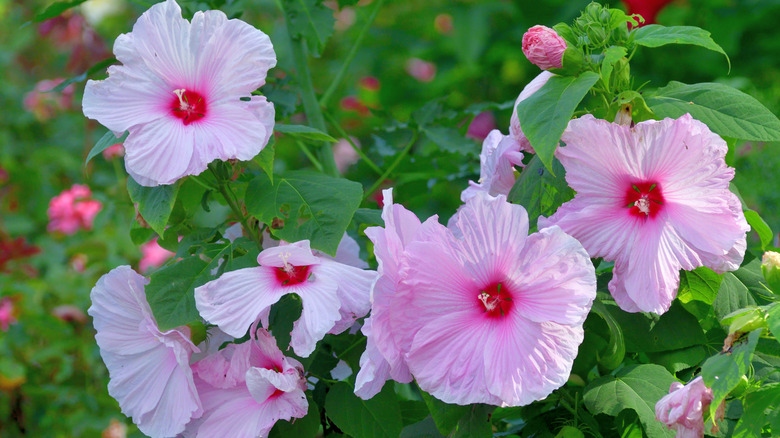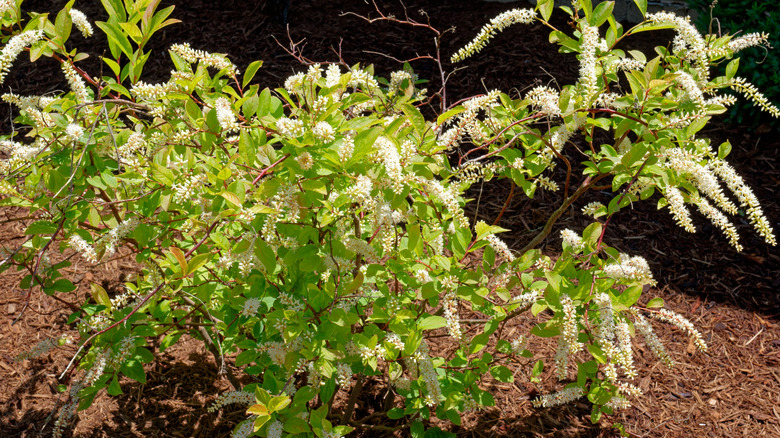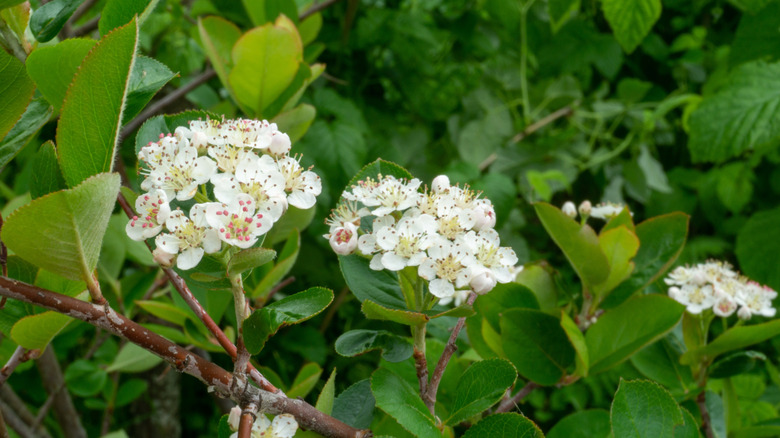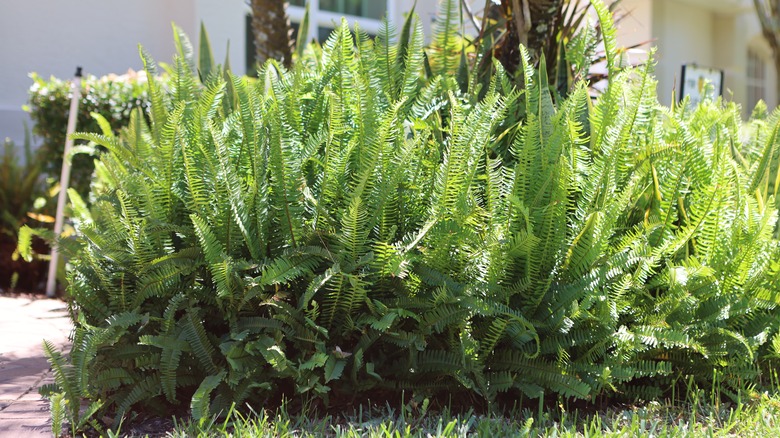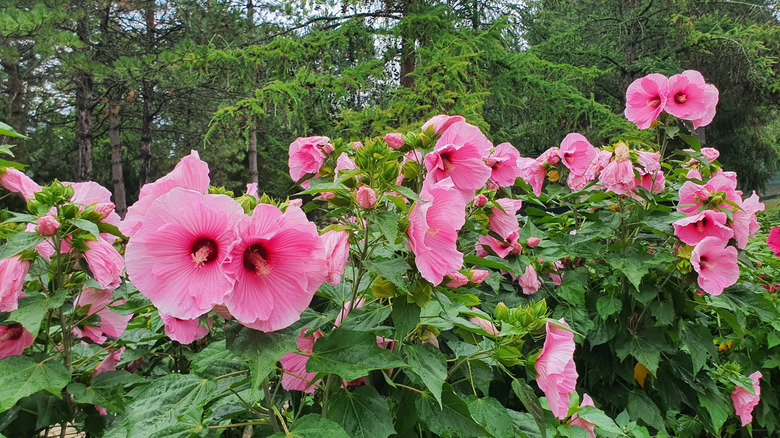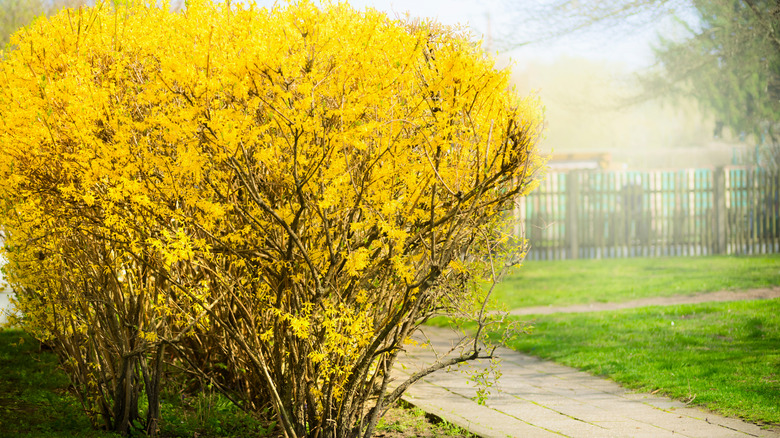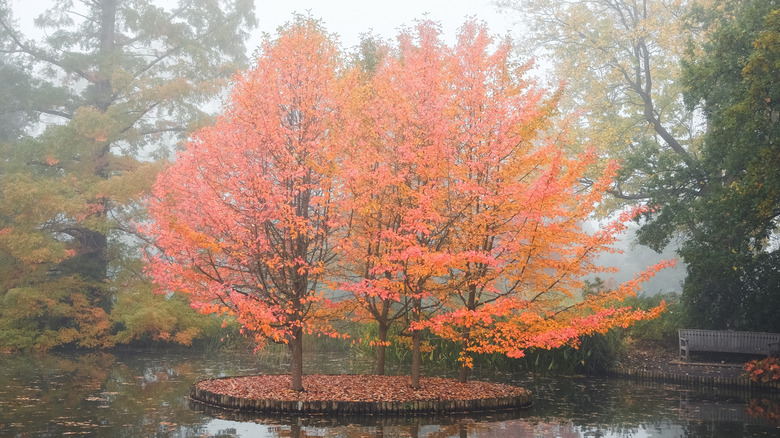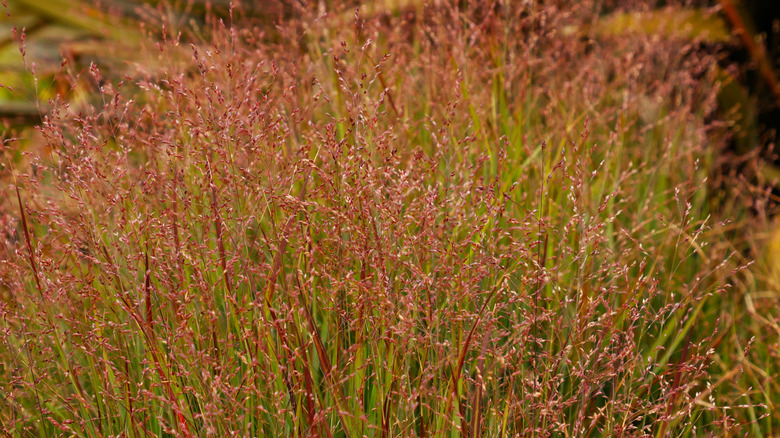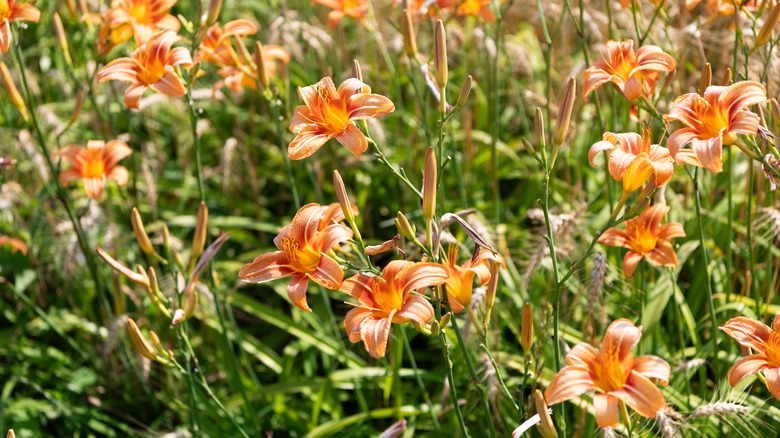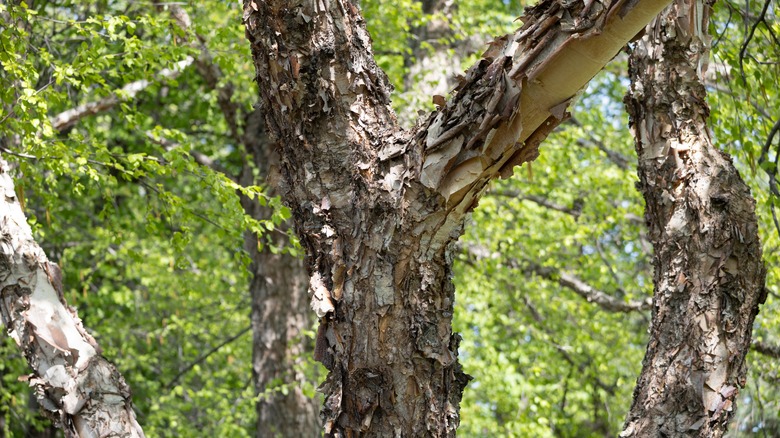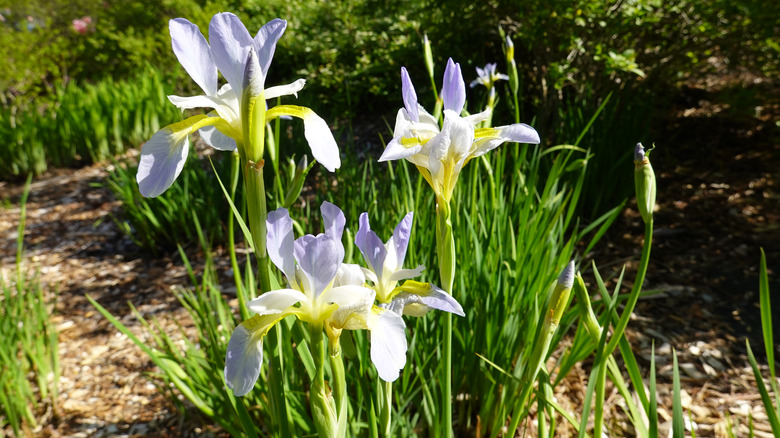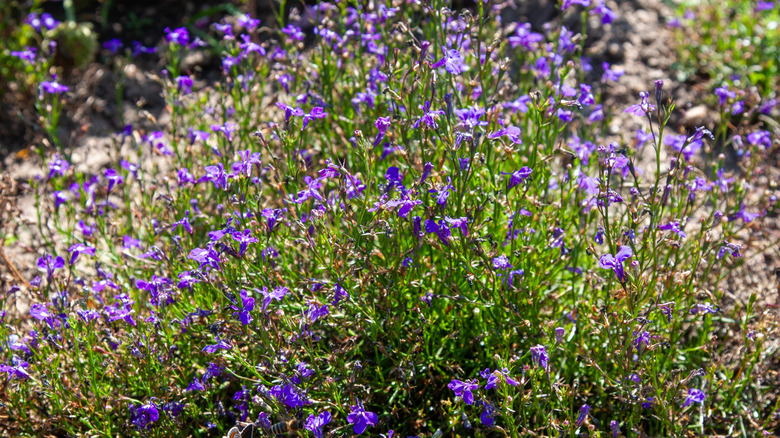11 Plants And Trees That Can Reduce Soil Erosion While Beautifying Your Yard
Soil erosion can be a serious problem, especially in large, sloped yards or areas that get a lot of water runoff. Heavy rains, snowmelt, flooding, winds, and extreme wet/dry cycles can loosen and carry away valuable topsoil, clogging drains, eroding embankments, and leaving areas of your yard barren and disturbed. On a larger scale, soil erosion can lead to increased pollution, threaten wildlife and water sources, or increase the risk of flooding or landslides. In your backyard, erosion can impact the fertility of your soil, making it more difficult for grass and other plants to grow as precious topsoil and organic matter gets washed away. In severe cases, erosion can direct water toward your foundations and destabilize entire slopes.
While you personally can't change conditions across the entire planet, there are some ways you can reduce soil erosion in your own backyard. Besides implementing landscaping techniques like terracing and mulching to slow water runoff, there are several plants and trees that can help you control erosion while also enhancing your landscaping and beautifying your space. Read on to learn how these species can help stabilize and protect that all-important layer of topsoil, and add an aesthetically pleasing element to your landscaping.
Sweetspire's cascading flowers can beautify your yard while its suckering root system holds soil in place
If you're looking to manage erosion while beautifying your yard, sweetspire is a versatile option to consider. Sweetspire has the tendency to sucker, forming dense thickets that can help hold the soil in place below. While most varieties of sweetspire offer good erosion control (especially for wet areas, such as streambanks, that experience flooding), 'Beppu' can be particularly useful for mass plantings on slopes, thanks to its low growth habit and sucker-driven spread. Sweetspire is also a highly adaptable plant that tolerates a variety of conditions: Even though it thrives in moist soil, it can also handle drought like a champ — and will grow in both full sun and shade, allowing you to place it just about anywhere in your yard where erosion is an issue.
Beyond its ability to manage erosion, this deciduous shrub can add beauty to your yard all year long. Towards the end of the spring, the shrub produces clusters of white flowers. Each cluster features a long, cylindrical shape, creating visual interest and standing in contrast to the other plants and blooms. These gorgeous clusters of flowers can also help attract butterflies to your yard. Sweetspire keeps its leaves longer than many other shrubs and plants in a typical garden, which don't drop until winter. In the fall, before they drop, the leaves take on a gorgeous red or purple color, adding more excitement to an otherwise bland garden at that time of the year.
Aronia forms soil-stabilizing thickets that produce pretty white flowers and colorful berries
Aronia, also called black chokeberry is a top pick for erosion control because of its ability to grow in wetter soil conditions and the way it spreads via a network of rhizomes to create thickets that stabilize the soil. For aronia to be the most effective, you'll probably want to plant several shrubs so they can form a mass planting that preserves the upper layer of topsoil. If you're looking for a denser grouping for better control, place them about 3-5 feet apart, depending on the specific variety. Mulching around the young aronias (as well as the other plants in your yard) can also help minimize erosion. Chokeberries do best in full sun, but can handle being partially shaded.
Besides helping to combat erosion, black chokeberry is a groundcover that will add striking color and year-round interest. During the spring and summer, it features vibrant green leaves. Clusters of white flowers grace the plants in the springtime. Towards the end of the summer or early in the fall, the chokeberries will ripen. These high-antioxidant fruits are edible, though they can be quite tart. Birds will flock to your yard to snack on the berries from the shrub; they don't seem to mind their tartness.
Ferns are known for their lush green appearance and their ability to stall runoff and erosion
Got a steeply sloped backyard? Erosion is common on slopes, and the steeper the incline, the worse the problem. Fortunately, ferns are ideally equipped to help you get the issue under control. The reason why ferns can be so helpful for combating erosion, particularly on slopes, lies in their tendency to form a dense cover over the soil, comprised of multiple plants, each anchoring itself (and the soil around it) with a network of wiry roots. If you've ever encountered a clump of sword fern, you'll know just what we're talking about. Ferns also grow well in moist soil and can thrive in the shade, making them ideal for shaded slopes where water runoff is carrying away the topsoil. A 2017 study published in Catena, an interdisciplinary journal of geomorphology and soil science, found that an 80% fern cover reduced the amount of sediment that was lost from a sloped area by 96.1%. As with the other species on this list, you'll want to begin with several starter plants to form a mass planting that will stall water and stop soil being transported downhill.
Ideally, prioritize fern species that are native to your area, and avoid invasive varieties like tuberous sword fern. While most ferns share a similar look with long green fronds, each variety offers unique characteristics that can add interest to your landscaping. The overall shape and texture of the leaves can vary as well as the height. While some ferns only reach about 1.5 feet, others may grow to be around 5 feet tall. Some ferns may change color during different seasons. The fronds of the cinnamon fern, for example, turn to a reddish-brown color during the summer. If you're planting ferns with different heights, a good rule of thumb is to place the shorter ones in front of a mass planting of larger species, so they don't get choked out by their taller cousins.
Rose mallow can stabilize banks while putting out big blooms
Rose mallow, a hibiscus hybrid, can help you control erosion while adding some strikingly beautiful blooms to your yard and garden. Despite their deceptively delicate-looking, dinner plate-like blossoms, once established, rose mallow plants are resilient, long-lived, and their root system can get massive. Because rose mallow is a water-loving plant, it won't be an effective solution for very dry soil, but it can thrive in most areas of the garden where the ground is moderately fertile and moist. And if you have a pond with a bank that could benefit from some stabilization, rose mallow may be the optimal plant for your needs. Similarly, consider planting it along the edges of a rain garden to help trap silt and hold soil in place.
There are a few different varieties, including lilac crush and scarlet rose mallow. Scarlet rose mallow produces gorgeous red blooms during the summer. These red flowers bear a resemblance to those of a tropical hibiscus, helping to turn your backyard into a true oasis. Lilac crush rose mallow brings a sweet and subtler charm with its purplish blue flowers. Your growing zone can also help you decide which variety is right for you. Lilac crush rose mallow is best suited to Zones 4 through 9, while scarlet rose mallow prefers warmer conditions and does best in Zones 6 through 9.
Forsythia is a fast-growing flowering shrub that can help minimize erosion
With its cheery yellow flowers that appear in the early spring, forsythia can add some color to your backyard landscaping. Once the beautiful bell-shaped flowers drop, the branches will be filled with green leaves to add color throughout the summer and into the fall. Forsythia can also be effective at controlling erosion. The plants grow quickly and their suckering roots spread out beneath the surface, forming a dense clump to minimize movement in the upper layer of soil. There are different varieties of forsythia to consider, but one that you might want to try for erosion control is weeping forsythia. This variety can be particularly useful for combating erosion because when its branches come into contact with the ground, they form additional roots to further prevent the topsoil from shifting. While forsythia prefers well-draining, fertile ground, the plant handles a range of soils. A full-sun position is ideal, as shade can impact flower production and trigger leggy growth.
Taking care of forsythia plants isn't hard once they're established. These pretty shrubs can grow up to 10 feet tall and 12 feet wide, so make sure you give them enough room. If left to its own devices, forsythia may take over areas where you have other plants growing in your backyard. However, if you prune it back after flowering (which will also encourage blooms for next year and prevent sprawling growth) and are purposeful about where you place your forsythias, you can keep this enthusiastic grower under control and still maintain a manicured landscape.
A black gum tree's deep roots can help stabilize embankments
If you're looking to plant a few trees to stabilize large areas of loose soil, a steep embankment, or a river bank, consider adding one or two black gums, also known as tupelo or sourgum. While black gums grow slower than some other trees, their genetic capability to form a deep root system can help them serve as an anchor that prevents soil from being able to shift beneath them. This deeper root system — complete with long taproots — also helps the tree tolerate drought-like conditions. If you live in an area that sees a mix of extended dry periods, followed by heavy rains that wash away soil, adding black gums to your landscaping could prove to be a real asset. When planting a black gum tree, keep in mind that they grow quickest in full sun and prefer acidic soil.
While this tree works to lock soil in place, it will simultaneously add visual appeal to your space. The bark of black gum trees is rather unique. It is gray in color and is often compared to alligator skin because of all of the ridges and smaller sections that give it a scaly appearance. In addition to interesting bark, the tree also features a long and straight trunk and lustrous leaves. In the fall when the leaves change color, they transition into a gorgeous shade of red.
Red switchgrass adds soft color while sending down deep roots and forming a dense covering
When you're on the search for ideal plants for your sloped yard, look no further than red switchgrass. It is a popular choice for those looking to control erosion, thanks to its extensive root system of interlacing rhizomes that form a dense mat, as well as roots that can grow 10 feet deep into the soil. This combination of tough, matting rhizomes and ultra-long roots is ideal for holding soil in place, stalling water, and trapping silt, which can be particularly helpful on a sloped yard where water is likely to be rushing down the hill during a heavy rain. Once it is established, red switch grass is also drought-tolerant, so it could be a viable option for areas that see periods of both dry spells and heavier rains. It is also salt tolerant, a valuable attribute for those who live on or near the coast.
Switchgrass isn't super fast to establish, especially during the first year of growth. But by the third year, it should start to provide decent cover, growing into thick stands that reach up to 6 feet tall. If you decide to add switchgrass to your yard to help with soil erosion, you can plant it in the spring, or during early fall, but you'll want to get it in the ground before the weather turns too cold. The grass thrives in sunlight, so select an area of your yard that receives a minimum of 6 hours of direct sun. Red switchgrass can grow in many different soils, however, a well-draining area, or one with added compost to assist with proper drainage will deliver the best results.
Clumping-forming daylilies can reduce erosion in sloped areas while producing delightful flowers
Daylilies can add eye-catching color to your yard while also holding the soil in place. Planting these flowers in sloped areas of your yard can be especially beneficial for minimizing erosion. These perennials grow vigorously, developing dense clumps within a few years, holding the topsoil around the plants in place and stalling sediment and water runoff. In most cases, you'll want to plant daylilies in full sun. However, if you live in a very warm climate and are planting darker-colored flowers, look for an area of the yard that receives some shade during the afternoon hours to prevent the flowers' color from bleaching.
Before you start thinking about caring for daylilies, it is important to note that some species of this flower, including Hemerocallis fulva and, to a lesser extent, Hemerocallis lilioasphodelus, are considered invasive in certain regions of the United States. However, don't let that convince you that you can't take advantage of the erosion-reducing capabilities of daylilies. Instead of opting for one of these varieties, choose a hybrid daylily instead. The hybrid varieties have clumping growth habits, making it safe to place them in all areas without concern that they will take over your yard or garden.
Stabilize extensive areas of topsoil with a river birch tree
A river birch tree can be a gorgeous addition to your backyard landscaping, provided you have sufficient room. The tree has an extensive root system which works to keep topsoil in place. Although the roots are not as deep as some other trees — staying within the top foot or two of soil — they can grow outwards to cover an area up to two times the height of the tree, which may equate to roughly a third of a football pitch. Because of this incredible root spread, river birch trees are ideal for erosion problems in the looser upper layers of soil, as opposed to large banks of earth that need stabilization. A river birch tree is adaptable to various soil types, giving it the potential to help in different yards, is highly hardy, and can handle both flooding and drought. However, you'll want to be careful to choose the right spot in your yard for this tree — aim to keep it away from structures, driveways, patios, and anything else that could interfere with the roots' ability to spread out properly. If you're looking to welcome more wildlife to your backyard, you'll also appreciate the number of visitors that frequent the tree to feed on its seeds, fruits, or even sap.
This fast-growing tree that also delivers cooling shade can reach heights of between 40 and 70 feet. It also gets wide, with the trunk's diameter reaching up to 2 ½ feet. The tree produces both male and female flowers; the wind blows the pollen from the male flowers to pollinate the female flowers, transforming them into a cone shape that holds tiny winged seeds. The male flowers are small and yellowish-brown in color, while the female flowers are an interesting green hue. Another intriguing part of the red birch tree's appearance is its bark. The bark peels and curls, giving the trunk a textured and multi-colored look.
Use pretty purple iris virginica in shoreline plantings to reduce erosion
The root system of the iris virginica makes it another top candidate for controlling soil erosion. As the roots and rhizomes spread underground, they clump together, helping to hold the topsoil in place, minimizing the chances of it getting washed away during a heavy rainstorm. Plants with rhizomes, such as the iris virginica, are often recommended for controlling erosion. However, it is important to note, that iris virginica is not a fast-growing plant. Its roots and rhizomes spread slowly, so you won't want to rely solely on it to quickly address an erosion problem. Instead, consider pairing it with other shoreline plantings to add visual interest to your space.
As a native plant to wetland regions iris virginica thrives in moist areas, such as rain gardens, marshes, or along other water sources — and can even grow in standing water that is up to 6 inches high. Although it requires full sun, iris virginica is very tolerant of colder weather and can grow well in Zones 1 through 5. Its gorgeous violet flowers are accented with hints of white and yellow, delivering a gorgeous view. And, even better, the flower will attract hummingbirds, bees, butterflies, and other pollinators to your yard.
Let great blue lobelia add color to your garden while fighting erosion in wet areas
If you want to control erosion — particularly if you are in an area that's prone to stormwater runoff — then great blue lobelia may be the perfect addition to your yard. Often recommended for shoreline plantings, great blue lobelia forms clumps and has a rhizomatous root system that anchors into the ground. These characteristics allow great blue lobelia to help keep soil in place, even when water is rushing over it. The plants can be so effective at controlling erosion that they are often recommended for stream restoration, which can involve controlling erosion to redirect a stream to its original path. Native to Wisconsin, great blue lobelia also grows well in USDA Hardiness Zones 4 through 9.
The plant can reach a height of up to 4 feet and grows blue-to-purple colored flowers from July through October. These flowers, which have a tubular shape, also help attract bees, hummingbirds, and other beneficial visitors to your yard. If you want to try to grow great blue lobelia to combat soil erosion, it will do best in an area with full or at least partial sunlight.
